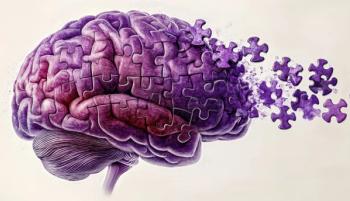
The Risk of Cerebrovascular Problems in Patients With Dementia Treated With Atypical Antipsychotics
The Risk of Cerebrovascular Problems in Patients With Dementia Treated With Atypical Antipsychotics
Sponsored by CME LLC for 1.5
Original release date 07/06. Approved for CME credit through June 2007.
Educational Objectives:
After reading this article, you will be familiar with:
- Concerns associated with the use of antipsychotics in patients with dementia
- Amount of risk for cerebrovascular adverse events (CVAEs) associated with various antipsychotics
- Mechanisms that may be involved in increasing the risk of CVAEs in patients with dementia
Who will benefit from reading this article?
Psychiatrists, primary care physicians, neurologists, nurse practitioners, psychiatric nurses, and other mental health care professionals. Continuing medical education credit is available for most specialties. To determine if this article meets the CE requirements for your specialty, please contact your state licensing board.
Dr Bullock is principal investigator and director at theKingshill Research Centre as well as a consultant andmanager of the old age psychiatry department atSwindon in the Avon and Wiltshire Mental Health CarePartnership NHS Trust in the UK. He reports that he hasundertaken clinical trials in the field of dementia fornumerous pharmaceutical companies, including studieson all the drugs mentioned in this article.
---
Antipsychotics have been seen as a mainstayof treatment for the behavioral andpsychological symptoms of dementia formany years. While their value is fairlyobvious in the more positive symptoms, such asagitation, psychosis, and aggression, their widespreadprescription for lesser symptoms has caused concernand led to a mistrust of their use. In many countries,the use of antipsychotics for behavioral andpsychological symptoms of dementia represents offlabeluse, even though it is supported by numerousrandomized controlled trials and meta-analyses.
The Omnibus Reconciliation Act of 1987 introducedguidance in the United States to restrict theuse of atypical antipsychotics to the most necessarycases and only after nonpharmacologic therapieshad been attempted.1 In late 2002, health regulatoryagencies in Canada and Switzerland raised concernsabout an association of risperidone with cerebrovascularadverse events (CVAEs) in clinical trialsin elderly dementia patients. The FDA and the UKCommittee for Safety in Medicine (CSM) soonfollowed and published recommendations restrictingthe use of risperidone and olanzapine in elderlypatients with dementia-citing the reason asa “clear risk of stroke” emerging from the randomizedstudies.2
The trial data
In the 11 randomized studies of risperidone andolanzapine conducted to date in elderly subjects withdementia, 48 (2.2%) of the 2187 patients treatedhad CVAEs, compared with 10 (0.8%) of the 1190patients in the placebo groups.3 The combined relativerisk was 2.7 (95% confidence interval, 1.4, 5.3).Of the 1009 patients treated with risperidone, 33(3.3%) had a CVAE, and of the 1178 treated witholanzapine, 15 (1.3%) had a CVAE; 5 patients treated with risperidone and 4 treated with olanzapinedied, compared with 1 in each of the placebogroups. This is a significant finding that merits thewarnings-especially considering that the CSM calculatedthe number of patients needed to be treatedto show harm (CVAEs) as 6.
However, as is often the case with pure data, thesefigures may not really tell the whole story. Cerebrovasculardisease increases with age, with a standardizedprevalence rate of stroke in persons olderthan 65 years of 46 to 72 per 1000 patient years.4Patients with cognitive impairment have an increasedrisk for cerebrovascular disease,5 independent of vascularrisk factors; and studies suggest that patientswith Alzheimer disease (AD) died of stroke morefrequently than elderly people without AD.6 It seemslikely that some of the patients studied in these 11trials would have CVAEs over a 12-week study period.However, there are still differences between risperidoneand olanzapine-and between each of thesedrugs and placebo-that need explaining.
In 6 studies of risperidone in nursing home residents(n = 1721), patients with dementias other thanAD (eg, vascular dementia, AD with cerebrovasculardisease) were included. This means that a thirdof the patients in the CVAEs analysis already had asignificant risk for such an event. In clinical trials CVAEs are grouped into a single category that includesserious events, such as stroke and cerebral infarct,but also less serious events, such as transient ischemicattack or cerebrovascular disturbance. If the CVAEsare divided into serious and not serious events, therates of serious events are not statistically differentfrom those in patients receiving placebo: 15 (1.5%)of the 1009 in the risperidone group, compared with4 (0.6%) of 712 in the placebo group. Of the subjectswith CVAEs, nearly all had major risk factors for stroke, including hypertension and atrial fibrillation;10 actually had a previous history of stroke.7
Although “not serious” CVAEs were more frequentwith risperidone (18 vs 4), issues around misdiagnosiswere raised in subsequent reviews that includedthe recording of orthostatic and sedative side effects and vasovagal faints as CVAEs. This suggests thatthe rates of CVAEs were lower and the differencebetween risperidone and placebo may have been anartifact created by imperfect coding of other effects.Thus, claims that the use of risperidone increased theincidence of stroke should be tempered. However, thestroke mortality rate was higher in the risperidonegroup than in the placebo group (13.9 vs 8.4 per1000 patient years), compared with no difference on all-cause mortality (182.3 vs 185.0), so the need forsuitable caution in this patient group remains, especiallyin patients with cerebrovascular disease.
The olanzapine data come from 5 trials: 4 involvedexclusively AD patients and 1 was a comparisonstudy with risperidone, composed of a mixed groupof AD, vascular dementia, and AD with cerebrovasculardisease. In the olanzapine group, 15 (1.3%)of 1178 patients were reported to have a CVAE,compared with 2 (0.4%) of 478 subjects in theplacebo group. This was statistically significant(p = .016), as was the difference in the mortality data:42 (3.5%) versus 7 (1.5%). These CVAE data werenot reported in the same way as the risperidone data;looking at serious versus not serious CVAEs or strokeincidence is not possible. Not much more can besaid about the olanzapine data from these particularstudies other than that the rates of CVAEs arelow and may look numerically different from risperidonebecause of shorter study duration and fewersubjects with preexisting vascular disease.3
Currently, no other studies of atypical antipsychoticshave been published, although several havebeen undertaken. Anecdotally, it appears that CVAEsoccur at similar rates in quetiapine studies, and thereare reports that the rates are the same for aripiprazoleas for placebo. These data need to be published beforefirm conclusions can be drawn, but the FDA has issueda statement about the mortality data and classed allof the atypical antipsychotics as having the potentialto increase mortality (odds ratio, 1.57).
Possible explanations for the CVAE findings
There are several potential explanations for the seeminglyhigher rates of CVAEs with atypical antipsychotics,but these remain hypotheses because no studyhas ever been undertaken to establish a causal relationship.All antipsychotics have been associated withvenous thromboembolism, to the extent that a warningin both the United States and United Kingdomis included in the labelling.8 This applies equally tothe older, typical antipsychotics and is probably a resultof platelet aggregation, although no data supportthis from either preclinical or clinical studies. Anticholinergicand α-adrenoceptor blockade may havean effect on cardiovascular homeostasis and may producetachycardia and orthostatic hypotension, both ofwhich have been associated with an increased risk forstroke.9 This would be a simple rationale, but in all therisperidone studies and all but one of the olanzapinestudies, there has been no difference shown betweenthe treatment and placebo groups in these measuresor ECG parameters and other vital signs.
Another mechanism may be alteration in vasculartone and reactivity in patients with dementia,leading to less adaptability to physiologic challenges.A large, unpublished German study of risperidonein patients with psychosis, but no dementia, did notfind a rate of CVAEs similar to that seen in elderlypatients with dementia; so this phenomenon doesseem related to dementia. Given that the incidenceis higher in those with preexisting vascular damageor risk factors, it is intuitive that a vascular causemay be the explanation.
A mechanism involving endothelial dysfunctioncould offer an explanation.10 Given that this is also a proposed mechanism of reduced energy in the brainsof patients with AD, the question remains: Whywould atypical antipsychotics make this differentiallyworse than placebo? Raised levels of prolactinhave been associated with impaired endothelial functionand platelet aggregation, leading to increasedatherosclerosis.11 Both risperidone and olanzapinehave the potential to raise prolactin levels; quetiapine,less so. In most cases this increase in prolactinlevel is often noticeable but at levels not much abovethe accepted upper range of normal. Thus, even thoughlevels were not taken in any of these studies in dementia,considerable overlap would be expected betweenthe placebo and active-treatment groups. Even if endothelial function were a mechanism, it wouldbe expected for this to result in longer-term sideeffects and not something that be seen in a 6- oreven 12-week study.
Other known side effects of atypical antipsychoticsare weight gain; changes in insulin metabolism;sedation; and the presence of extrapyramidalside effects (EPS), albeit at much lower levels thanwith typical antipsychotics. The trials were too shortfor the metabolic effects to have an influence, butsedation and EPS could have contributed to venousstasis and indirectly increased the risk for CVAEs.Risperidone was found to cause dose-dependent EPSin a US study,12 whereas in studies with olanzapine,there were no differences shown with placebo; thus,it is difficult to draw any conclusions about EPS asa contributing mechanism. Sedation featured in allantipsychotic studies and it can be postulated thatthe resulting dehydration increased the risk forCVAEs (although this was not supported by laboratorytests performed during the studies and so wouldappear unlikely).
Were the warnings warranted?
The warnings about risperidone and olanzapine grewout of post hoc analyses that suffered from multiplecomparisons. The CSM used a random-effects modelwhen the studies they selected were not random,especially for cerebrovascular risk factors, and madeassumptions that what happened in a 6-week studycontinued to be a constant effect over a year whenstating their number needed to treat. This is clearlynot the case and the error is compounded when theresults for all patients, both high and low risk, arepooled. Such an approach may result in spurious conclusionsthat may preclude all patients with dementiafrom having a viable treatment option.13
After the warnings appeared, the use of risperidoneand olanzapine dropped dramatically. Manypatients had these drugs phased out and did not actuallyrequire further treatment because their symptomsdid not return, which reinforced the need for regularreview of a patient's pharmacotherapy. Others were given alternative antipsychotics, includingtypical antipsychotics, which had generally falleninto disuse because of their propensity for causingEPS and other harmful side effects.
What was not apparent was whether the typicalantipsychotics had the same association with CVAEs.No specific data exist, but several large observationalstudies included typical antipsychotics in their analyses.Interpretation from these studies is clearly opento certain biases and lacks the control of randomizedclinical trials but does allow the study of low frequencyevents in large numbers of patients.
A review of Medicaid records between 1999 and2002 looked at more than 18,000 admissions for a stroke-related event in patients with dementiatreated with a psychotropic agent in the previous90 days.14 The results showed no increased riskwith the atypical antipsychotics but a doubling ofthe risk with haloperidol and benzodiazepines.Another case-control study in nursing homes lookedat 1130 subjects treated with antipsychotics, comparedwith 3658 controls, and again found no statisticalseparation from nonusers.15 A study in Ontario,Canada, compared all adults over 65 years (11,400)on risperidone or olanzapine therapy with thoseusing typical antipsychotics between 1997 and2002.16 The risk ratios for stroke were the same forthe atypical and typical antipsychotics, whichsuggests that use of typical antipsychotics followingthe warnings did not confer extra safety.Considered together, these studies suggest thatatypical antipsychotics have no more risk than eitherno treatment or typical antipsychotic treatment andare perhaps safer than haloperidol or benzodiazepines.Properly designed studies are needed toconfirm this, but the results of the Canadian studiesoffer a certain reassurance.
In terms of clinical practice, it would seem thatthe atypical antipsychotics are not quite as harmfulas originally thought and that the warnings, whileproduced for the correct reasons, may have beenpremature. At the time, risperidone in particular,and olanzapine were commonly used in the treatmentof behavioral and psychological symptoms ofdementia, especially if nonpharmacologic methodshad failed. The warnings had such a high impactprimarily because of a lack of available options fortreating a common condition for which some interventionis often expected.
Reviews of nonpharmacologic treatments oftenshow small, methodologically problematic studieswith little or no effect on the target symptoms, thusnot offering real alternatives, especially in aggressionand psychosis. Other treatments that have been suggested,such as trazodone and other antidepressants,mood stabilizers, and benzodiazepines, also have noconvincing evidence of reliable effect. The evidence base is firmly with atypical antipsychotics, particularlyrisperidone.
Conclusion
Guidelines still suggest the use of atypical antipsychoticsbut with more circumspection. It is clear thatwith risperidone, the serious CVAEs are associatedwith those patients who have the most cerebrovascularrisk factors; this is likely to be the case with allatypical antipsychotics. Identification and managementof these factors should help in the treatment ofthe underlying dementia and serve to minimize riskshould antipsychotics be required. Armed with thisinformation, clinicians should not stop using a classof useful drugs across all patients with dementia.
More important, there is no reason to use typicalantipsychotics as an alternative therapy becausethey have the same incidence of ischemic strokeregardless of which atypical antipsychotic they arecompared with, or when different levels of baselinecerebrovascular risk are allowed for.17 Instead, cerebrovascularrisk is part of a treatment-decision pathwayin which hypertension and atrial fibrillation treatmentplay an equal role to managing the actual behavioraland psychological symptoms of dementia. Inadopting this approach and maintaining close communicationwith caregivers and families, the best ofthe current treatments can be used logically and safelyto good effect where they are needed most.
Psychiatric Times - Category 1 Credit
If you are a first-time user, you must update your profile.
If you are not on the Lifelong Learning site,
You must keep your own records of this activity. Copy this information and include it in your continuing education file for reporting purposes.
CME LLC is accredited by the Accreditation Council for Continuing Medical Education to provide continuing medical education for physicians. CME LLC designates this educational activity for a maximum of 1.5 category 1 credits toward the AMA Physician's Recognition Award. Each physician should claim only those credits actually spent on the educational activity.
CME LLC is an approved provider of continuing medical education for physicians, nurses and physician assistants in the State of Florida and is registered with CE Broker.
CME LLC is approved by the California Board of Registered Nursing, Provider No. CEP12748, and designates this educational activity for 1.5 contact hours for nurses. The American Nurses Credentialing Center (ANCC) accepts AMA category 1 credit toward recertification requirements.
References:
References
1. Semla TP, Palla K, Poddig B, Brauner DJ. Effect of the Omnibus Reconciliation Act 1987 on antipsychotic prescribing in nursing home residents. J Am Geriatr Soc. 1994;42:648-652.
2. Committee on Safety of Medicines. Summary of clinical trial data on cerebrovascular adverse events (CVAEs) in randomized clinical trials of risperidone conducted in patients with dementia. Available at http://www.mhra.gov.uk. Accessed June 2, 2006.
3. Herrmann N, Lanctot KL. Do atypical antipsychotics cause stroke? CNS Drugs. 2005;19:91-103.
4. Feigin VL, Lawes CM, Bennett DA, Anderson CS. Stroke epidemiology: a review of population-based studies of incidence, prevalence, and case-fatality in the late 20th century. Lancet Neurol. 2003;2:43-53.
5. Gale CR, Martyn CN, Cooper C. Cognitive impairment and mortality in a cohort of elderly people. BMJ. 1996;312:608-611.
6. Ostbye T, Hill G, Steenhuis R. Mortality in elderly Canadians with and without dementia: a 5-year follow-up. Neurology. 1999;53:521-526.
7. Greenspan A, Eerdekens M, Mahmoud R. Is there an increased rate of CVAEs with risperidone in patients with dementia. Int J Neuropsychopharmacol. 2004;7(suppl):S205.
8. Zornberg GL, Jick H. Antipsychotic drug use and risk of first time idiopathic venous thromboembolism: a case-control study. Lancet. 2000;356:1219-1223.
9. Arnt J, Skarsfeldt T. Do novel antipsychotics have similar pharmacological characteristics? A review of the evidence. Neuropsychopharmacology. 1998;18:63-101.
10. Yavuz D, Deyneli D, Akpinar I, et al. Endothelial function, insulin sensitivity and inflammatory markers in hyperprolactinemic premenopausal women. Eur J Endocrinol. 2003;149:187-193.
11. Wallaschofski H, Donne M, Eigenthaler M, et al. PRL as a novel potent cofactor for platelet aggregation. J Clin Endocrinol Metab. 2001;86:5912-5919.
12. Katz IR, Jeste DV, Mintzer JE, et al. Comparison of risperidone and placebo for psychosis and behavioural disturbances associated with dementia: a randomized, double-blind trial. J Clin Psychiatry. 1999;60:107-115.
13. Smeeth L, Haines A, Ebrahim S. Numbers needed to treat derived from meta-analyses: sometimes informative, usually misleading. BMJ. 1999;318:1548-1551.
14. Finkel S, Kozma C, Long S, et al. Risperidone treatment in elderly patients with dementia: relative risk of cerebrovascular events versus other antipsychotics. Int Psychogeriatr. 2005;17:617-629.
15. Liperoti R, Gambassi G, Lapane KL, et al. Cerebrovascular events among elderly patients treated with conventional or atypical antipsychotics. J Clin Psychiatry. 2005;66:1090-1096.
16. Herrmann N, Mamdani M, Lanctot KL. Atypical antipsychotics and the risk of cerebrovascular accidents. Am J Psychiatry. 2004; 161:1113-1115.
17. Gill SS, Rochon PA, Hermann N, et al. Atypical antipsychotics and risk of ischaemic stroke: population based retrospective cohort study. BMJ. 2005;330:445-450.
Newsletter
Receive trusted psychiatric news, expert analysis, and clinical insights — subscribe today to support your practice and your patients.













